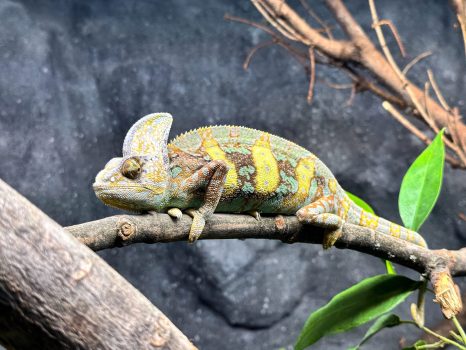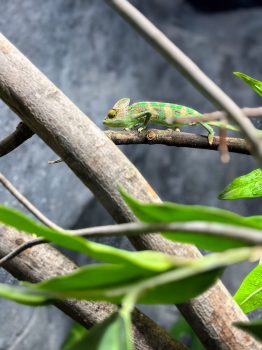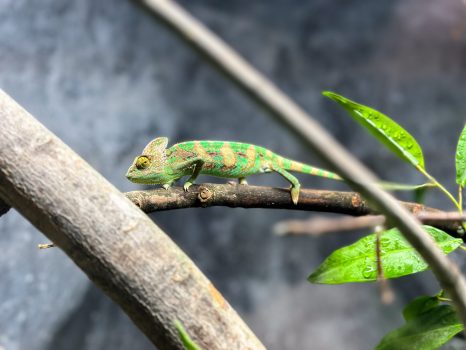Veiled Chameleon
Common Name: Veiled Chameleon
Scientific Name: Chamaeleo calyptratus
Names: N/A
Locations: Whitby, Vaughan & London



Diet
Veiled Chameleons are insectivores, primarily feeding on a diet consisting of insects such as crickets, locusts, roaches, and mealworms. They may also consume occasional vegetation such as leaves and fruits.
Average lifespan
In the wild, Veiled Chameleons typically live around 5 to 7 years, though they may live longer in captivity with proper care.
Size
Veiled Chameleons are medium-sized chameleons, with adults reaching lengths of up to 35 to 50 centimeters (14 to 20 inches) from snout to tail tip.
Weight
Adult Veiled Chameleons can weigh anywhere from 85 to 170 grams (3 to 6 ounces), with males generally being larger and heavier than females.
About
Veiled Chameleons are native to the Arabian Peninsula, particularly found in countries such as Yemen and Saudi Arabia. They inhabit a variety of habitats including forests, savannas, and mountainous regions, where they can find suitable food and shelter.
Size and behavior
Veiled Chameleons have a distinctive appearance characterized by their casque (helmet-like structure) on their heads, crests along their backs, and prehensile tails. They are arboreal reptiles, spending much of their time in trees and bushes where they can blend in with their surroundings and hunt for prey. They are also known for their unique ability to change color, which they use for communication, thermoregulation, and camouflage.
Diet and nutrition
Veiled Chameleons require a diet rich in insects and supplemented with occasional vegetation. In captivity, they can be fed a variety of live or gut-loaded insects such as crickets, roaches, and mealworms, as well as occasional fruits and vegetables. Providing a varied diet ensures that they receive the necessary nutrients for growth, hydration, and overall health.
Conservation status
The conservation status of Veiled Chameleons in the wild is not well-documented, but they are generally not considered to be threatened or endangered species. However, they may face localized threats from habitat loss, deforestation, and collection for the pet trade in some areas.
Fun fact
Veiled Chameleons are famous for their unique ability to change color, which they use for communication, thermoregulation, and camouflage. Contrary to popular belief, their color-changing ability is not solely for camouflage but also plays a role in social interactions, mating displays, and regulating body temperature. Additionally, Veiled Chameleons have independently moving eyes, allowing them to scan their surroundings for prey and predators without moving their heads.
Call or visit your local Reptilia Facility to learn how you can adopt one of these amazing reptiles.










